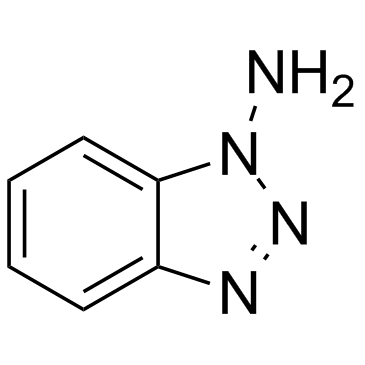1-Aminobenzotriazole

1-Aminobenzotriazole structure
|
Common Name | 1-Aminobenzotriazole | ||
|---|---|---|---|---|
| CAS Number | 1614-12-6 | Molecular Weight | 134.139 | |
| Density | 1.5±0.1 g/cm3 | Boiling Point | 319.3±25.0 °C at 760 mmHg | |
| Molecular Formula | C6H6N4 | Melting Point | 81-84 °C(lit.) | |
| MSDS | Chinese USA | Flash Point | 146.9±23.2 °C | |
| Symbol |

GHS07 |
Signal Word | Warning | |
|
Chemical genetics reveals a complex functional ground state of neural stem cells.
Nat. Chem. Biol. 3(5) , 268-273, (2007) The identification of self-renewing and multipotent neural stem cells (NSCs) in the mammalian brain holds promise for the treatment of neurological diseases and has yielded new insight into brain cancer. However, the complete repertoire of signaling pathways ... |
|
|
Morphological behaviour and metabolic capacity of cryopreserved human primary hepatocytes cultivated in a perfused multiwell device.
Xenobiotica 45(1) , 29-44, (2014) 1. The quantitative prediction of the pharmacokinetic parameters of a drug from data obtained using human in vitro systems remains a significant challenge i.e. prediction of metabolic clearance in humans and estimation of the relative contribution of enzymes ... |
|
|
Quantitative assessment of intestinal first-pass metabolism of oral drugs using portal-vein cannulated rats.
Pharm. Res. 32(2) , 604-16, (2015) To evaluate the impact of intestinal first-pass metabolism (Fg) by cytochrome P4503A (CYP3A) and uridine 5'-diphosphate-glucuronosyltransferases (UGT) on in vivo oral absorption of their substrate drugs.CYP3A and UGT substrates were orally administered to por... |
|
|
Using improved serial blood sampling method of mice to study pharmacokinetics and drug-drug interaction.
J. Pharm. Sci. 104(3) , 955-61, (2015) In pharmacokinetic evaluation of mice, using serial sampling methods rather than a terminal blood sampling method could reduce the number of animals needed and lead to more reliable data by excluding individual differences. In addition, using serial sampling ... |
|
|
A comparison of the metabolism of midazolam in C57BL/6J and hepatic reductase null (HRN) mice.
Biochem. Pharmacol. 92(4) , 701-11, (2014) The hepatic cytochrome P450 reductase null (HRN) mouse, which has no functional hepatic Cyp P450s, may represent a useful model for examining extra-hepatic P450-related oxidative metabolism. Here the pharmacokinetics and metabolic fate of midazolam, a drug kn... |
|
|
Degradation of selected agrochemicals by the white rot fungus Trametes versicolor.
Sci. Total Environ. 500-501 , 235-42, (2014) Use of agrochemicals is a worldwide practice that exerts an important effect on the environment; therefore the search of approaches for the elimination of such pollutants should be encouraged. The degradation of the insecticides imiprothrin (IP) and cypermeth... |
|
|
In Vitro Assessment of Uptake and Lysosomal Sequestration of Respiratory Drugs in Alveolar Macrophage Cell Line NR8383.
Pharm. Res. 32 , 3937-51, (2015) To assess accumulation and lysosomal sequestration of 9 drugs used in respiratory indications (plus imipramine as positive control) in the alveolar macrophage (AM) cell line NR8383.For all drugs, uptake at 5 μM was investigated at 37 and 4°C to delineate acti... |
|
|
Genetic mapping of targets mediating differential chemical phenotypes in Plasmodium falciparum.
Nat. Chem. Biol. 5 , 765-71, (2009) Studies of gene function and molecular mechanisms in Plasmodium falciparum are hampered by difficulties in characterizing and measuring phenotypic differences between individual parasites. We screened seven parasite lines for differences in responses to 1,279... |
|
|
'Stealth' lipid-based formulations: poly(ethylene glycol)-mediated digestion inhibition improves oral bioavailability of a model poorly water soluble drug.
J. Control. Release 192 , 219-27, (2014) For over 20years, stealth drug delivery has been synonymous with nanoparticulate formulations and intravenous dosing. The putative determinants of stealth in these applications are the molecular weight and packing density of a hydrophilic polymer (commonly po... |
|
|
Arachidonic acid promotes skin wound healing through induction of human MSC migration by MT3-MMP-mediated fibronectin degradation.
Cell Death Dis. 6 , e1750, (2015) Arachidonic acid (AA) is largely released during injury, but it has not been fully studied yet how AA modulates wound repair with stem cells. Therefore, we investigated skin wound-healing effect of AA-stimulated human umbilical cord blood-derived mesenchymal ... |